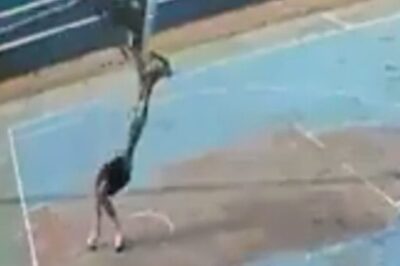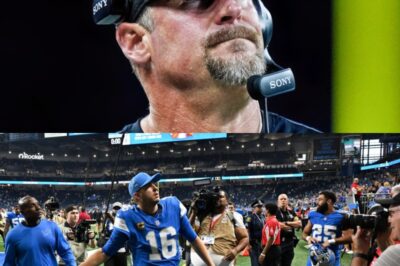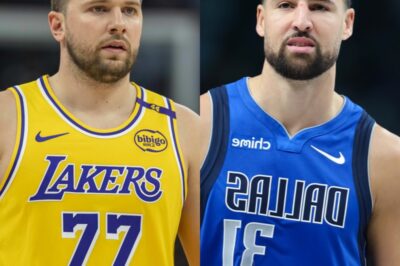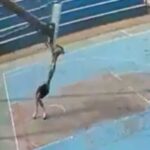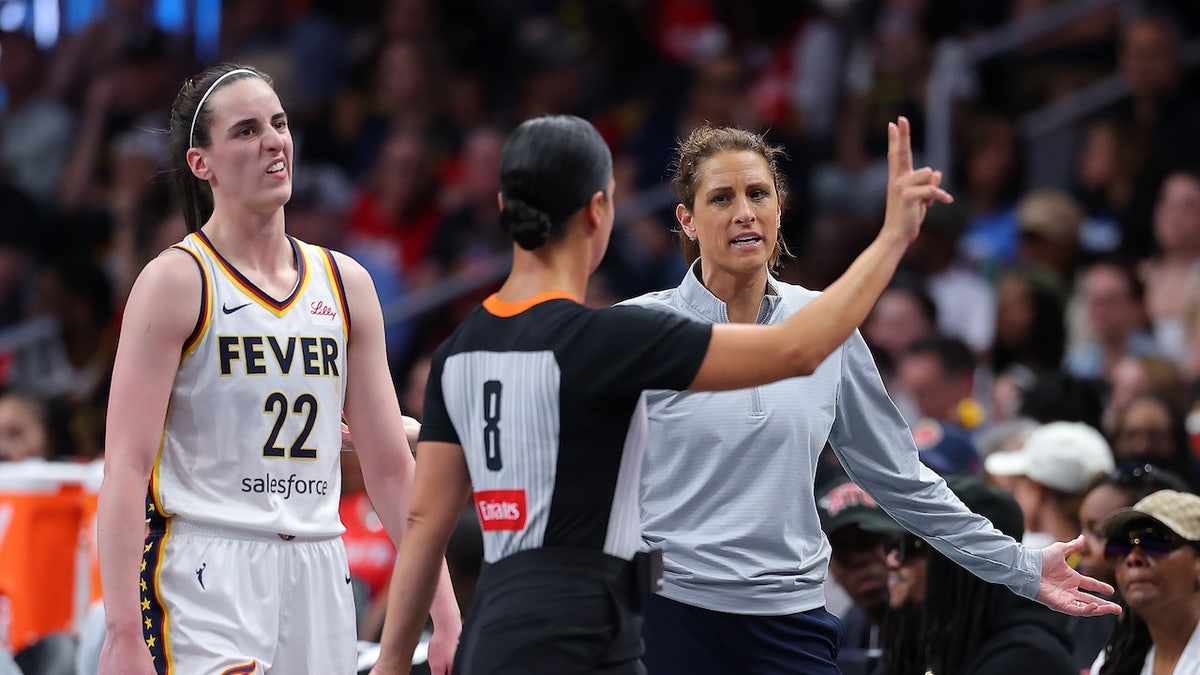
It’s supposed to be the moment everyone remembers for the right reasons—a packed arena, playoff fever in the air, Caitlin Clark doing what she does best: slicing through defenders, making the impossible look routine, electrifying the crowd with every step. But what happened on that night in Indianapolis will be remembered for something else entirely. It started in the third quarter, with the Fever and the Liberty locked in a battle that felt bigger than the standings. Clark was in her element, darting off a screen, eyes locked on the rim, the crowd rising in anticipation. Then, in a split second, everything changed. A defender stepped into her path, there was a tangle of legs, and Clark’s knee twisted in a way knees simply aren’t meant to twist. For a heartbeat, no one reacted. The arena, so loud a moment before, fell into a hush so thick you could hear the squeak of sneakers on hardwood. Seven long seconds ticked by before anyone moved, before the trainers sprinted out, before A’ja Wilson clapped a hand over her mouth in shock, before the reality set in. Clark tried to get up—of course she did, she’s nothing if not tough—but her body betrayed her. She crumpled again, pain etched across her face, and in that instant, it wasn’t just her knee that collapsed, but the collective breath of everyone watching, in the building and at home.
The broadcast, usually so quick to replay every angle, every collision, seemed to look the other way. There was no slow-motion breakdown, no forensic analysis, just a quick cut to commercial, as if pretending it hadn’t happened might make it so. The commentators, usually so eager to fill the silence, said little. Maybe they were stunned, maybe they were told to move on. Either way, the moment hung in the air, unresolved, unsettling. The WNBA, for its part, stayed quiet. No explanation, no official word beyond the most basic injury update. The game resumed, but it felt like everyone was just going through the motions, the spark gone, the shadow of what had just happened lingering over everything.
But the world doesn’t work on the league’s schedule anymore, not with social media watching. Twelve hours later, a video hit Twitter—clear, unfiltered, shot from two angles the TV feed never showed. It told the story the league didn’t want to tell. You saw the defender plant her knee wide, you saw Clark’s leg swept out as she drove, you saw the moment of hesitation, then the full-body contact that sent her crashing to the floor. The reaction online was swift and furious. “That wasn’t defense. That was reckless,” one user wrote, summing up the outrage that was spreading like wildfire. “This is a scandal—and we all just saw it happen live.” The clip racked up a million views in three hours. By sunrise, it was five million and counting. It started trending under a phrase that said it all: The Play They Tried to Bury.
The league’s silence became its own story. Two days passed before the WNBA released a statement, the kind of bland corporate boilerplate that only made people angrier: “Player safety remains our top priority. We are actively reviewing the play and officiating decisions.” But then, out of nowhere, the announcement dropped: the lead referee from that game was suspended pending investigation. No details, no mention of Clark, no reference to the viral clip. But everyone knew what it was about. The internet had already connected the dots. “She screamed. They swallowed the whistle,” one fan wrote. “This league doesn’t protect its stars. It protects silence.” It wasn’t about a missed foul anymore. It was about what didn’t happen in that moment, about how the league seemed so eager to move on, to pretend it hadn’t seen what everyone else had.
Players started speaking out. A’ja Wilson, who’d witnessed the whole thing from a few feet away, didn’t hold back: “That wasn’t just a missed call. That was a failure. Caitlin deserves better.” Sabrina Ionescu, the defender in the play, tried to defend herself: “I’m aggressive. But I’m not dirty. If I hurt her, it wasn’t intentional.” Some took her side, many didn’t. The footage spoke louder than any statement. Then the story took another turn: ESPN insiders leaked that the suspended ref had been warned in previous games for similar non-calls involving Clark. Suddenly, this wasn’t just about one play, one game, or even one referee. It was about a pattern—a pattern of letting things slide, of looking the other way when it mattered most.
The questions started piling up, louder than any official statement. Why was there no whistle in the moment? Why was there no replay on the national broadcast? Why did the league only respond after the video went viral? Theories started to swirl. Was the league trying to protect certain players? Was this about race, rivalry, or ratings? Had Clark become too big, too fast for a system that wasn’t ready—or willing—to protect her? No one in the league office had answers, or if they did, they weren’t sharing them. And that silence, once again, became part of the story.
Through it all, Clark herself stayed silent. No tweets, no press conferences, no sideline appearances. Insiders say she’s recovering quietly, watching, listening, weighing her next move. Her teammates describe her as composed, focused, but this time not on the next game—on what the league does next. “She gave the WNBA the spotlight,” one Fever coach said. “Now that it’s on… we see the cracks.” The fallout exposed more than just bad officiating. Former referees came forward anonymously, saying certain players were “protected,” that internal reviews were “performative,” that high-profile stars were told to “take hits in silence.” Sponsors started to get nervous. Fan pages turned aggressive. And in every comment thread, one phrase kept popping up: “This league doesn’t deserve her.”
The WNBA tried to get ahead of the outrage, launching an external investigation into the game, the officiating, the video review process. They suspended the referee, promised transparency, formed a new “Player Protection Task Force.” But for many fans, it was too little, too late. Because the most-watched player in women’s basketball went down, and the league said nothing—until Twitter forced their hand. “If it wasn’t Clark, would this even be a story?” one fan asked. “She’s the reason half of us even tuned in.” And that’s the uncomfortable truth: this wasn’t just a missed call, or a viral clip, or a suspension. It was a moment that forced the WNBA to choose: protect the product, or protect the player? And in that split second of hesitation, they revealed more about themselves than any press release ever could.
Now, as Clark begins the long road back, the league finds itself under a microscope like never before. Every decision, every statement, every silence is scrutinized, replayed, dissected. The investigation is ongoing, the outcome uncertain, but one thing is clear: the WNBA can’t go back to business as usual. Not when the world is watching. Not when the trust of its fans—and its brightest star—hangs in the balance. This isn’t just about Caitlin Clark. It’s about what kind of league the WNBA wants to be, and whether it has the courage to face its own flaws. Because in the end, it’s not the fall that defines you. It’s how you get back up. And right now, everyone is waiting to see if the league can do the same.
News
Social Media Erupts When A Former Producer Reveals The Unexpected Network Move That Pushed Judge Judy Off TV In The Most Chaotic Way
Millions of viewers tuned in to watch Judge Judy Sheindlin decide real court cases on national TV for over two…
Female Alabama Fan Exposed In 4K After Allegedly Using “N-Word” Towards Black Man In The Stands [VIDEO]
Alabama Crimson Tide fans (Photos via Twitter) No. 10-ranked Alabama Crimson Tide took down the Eastern Illinois University Panthers 56-0…
Freak Tragedy: 16-Year-Old National-Level Basketball Star K%lled After Net Horrifically Collapses On Him [VIDEO]
Hardik Rathi (Photo via Twitter) The d3ath of 16-year-old basketball player Hardik Rathi has left thousands of people in complete…
BREAKING: NFL Drops The Hammer – Announces 3 Harsh Punishments On Detroit Lions
The NFL has issued fines to three Detroit Lions players stemming from their actions in last week’s overtime home win over the New…
HEARTBREAKING: Bachelor Star Reveals Heartbreaking Battle With Illness As Extreme Hair Loss Leaves Fans Devastated
A Bachelor star shared an update on her life. She revealed that she’s single again and battling an illness that’s causing massive…
Luka Doncic Smacks Klay Thompson After Hitting Him With Multiple Pump Fakes [VIDEO]
Luka Doncic and Klay Thompson (Photo By X/@TheLakerSource) The Los Angeles Lakers faced the Dallas Mavericks on Friday at Crypto.com Arena in…
End of content
No more pages to load



